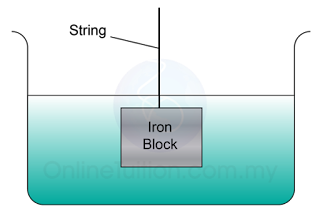A balloon filled with helium gas has negligible mass. The volume of the balloon is 120cm³. [Density of air = 1.23 kg/m³.Density of helium gas = 0.18 kg/m³]
- Calculate the mass of the helium gas in the balloon?
m=ρV m=(0.18)(120× 10 −6 )=2.16× 10 −5 kg
- Find the weight of the helium gas?
W=mg W=(2.16× 10 −5 )(10)=2.16× 10 −4 N The balloon is then tied to a load of mass m kg, as shown in figure above. The balloon and the load float in the air stationary.
- Mark in the diagram, all the forces that acted on the balloon.
- Write an equation to relate all the forces in )b) (i).
All the 3 forces are in equilibrium
Upthrust = Weight of the Load + Weight of Helium Gas
- Calculate the mass of the load, m.
Upthrust = Weight of the Load + Weight of Helium Gas ρVg=mg+2.16× 10 −4 (1.23)(120× 10 −6 )(10)−2.16× 10 −4 =m(10) m=1.26× 10 −4 kg
- If the string that is tied to the balloon is cut, Find upward acceleration experienced by the balloon?
Net force acted on the balloon = mg = (1.26 x 10-4)(10) = 1.26 x 10-3N
Mass of the helium gas, m = 2.16 x 10-5kg
F=ma (1.26× 10 −3 )=(2.16× 10 −5 )a a= 1.26× 10 −3 2.16× 10 −5 =58.3m s −2


























